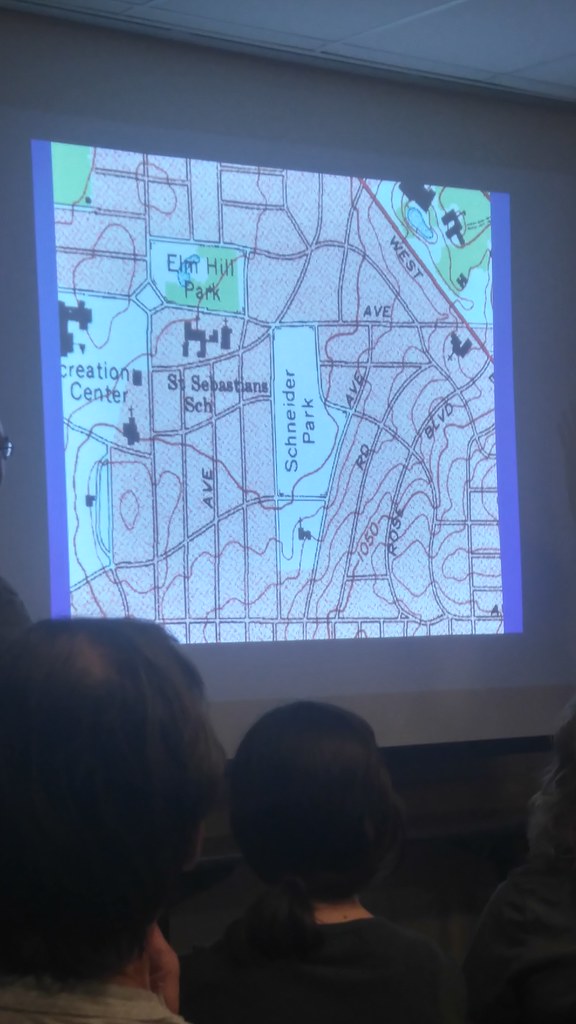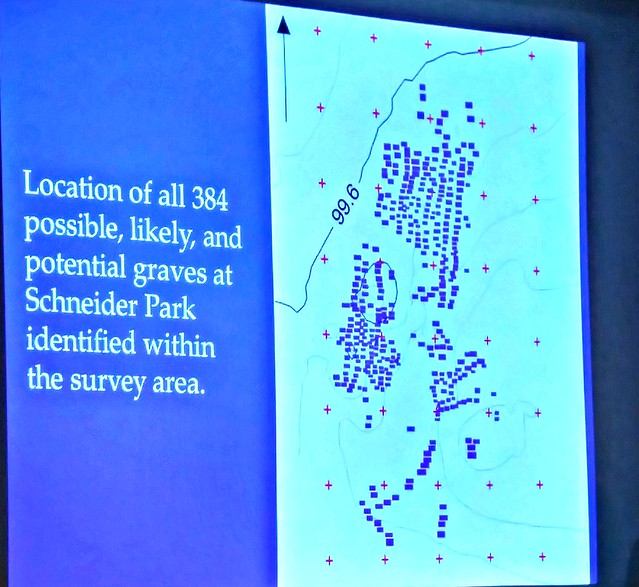
As I blogged last week in my 7-Quick Takes post, archeology students from the University of Akron were studying Schneider Park – a city park on the west side of Akron, OH, about a block from my church parish of St. Sebastian. The student’s interest in studying the park came from a 2009 article in the Akron Beacon Journal, “Poor Lost Souls” by Beacon Journal history writer Mark J. Price. about an abandoned cemetery underneath the athletic fields, dog walking, and other park-like activities at Schneider Park.
In 2017, Professor Tim Matney led his student team of 14 anthropology students (undergrads and a few grad students) on a three-week study of the park using modern archeology equipment. For their final exam, the students gave a presentation in the meeting room of the Akron-Summit County Public Library at Highland Square.
In 1849 Zachary Taylor was president. That same year regular steamboat service between the East Coast and the West Coast around the Cape Horn of South America began. Near what we know as Akron, OH, the Summit County Infirmary was also founded to house the poor and the disabled. It was a 230-acre working farm and the residents were self-sufficient.
All was well until 1887 when one of the inmates had a baby. Investigations into the misconduct of the staff and mistreatment of the inmates were started. The superintendent and the doctor were fired.
The doctor, Dr. Alvin K Fouser, was also the coroner. He was charged with grave robbing and it was said that he would dig up and sell the bodies of the inmates buried at the infirmary to medical schools all over the country. You can read more about that here in an excerpt from Wicked Akron: Tales of Rumrunners, Mobsters and Other Rubber City Rogues.
All was, more or less, well after that. By 1910 the Infirmary farm was 340 acres. With the growth of the city of Akron, the land was valued at $1000/acre. Philip P. Schneider bought the place for a little over $300,000 and set about to subdivide the place through his real estate company.
It was said that the cemetery was moved to Monroe Falls. The University of Akron students said that there were no records of any bodies being moved. It was also rumored that the WPA came in 1936 to exhume the bodies of some deceased infants, but again there are no records to support that.
In 2001 archeology equipment was purchased by the University of Akron to train archeology students and prepare them to work in the field. That is the equipment students took out to Schneider Park.
Their primary instruments were Magnetic Gradiometry, which measures magnetics, and Resistivity which puts electrical current into the ground and measures the resistance.
Different substances have different properties of resistance. If the current runs into brick stone, cement, or compact soil, the current will resist going through it and try to find an easier way. Soil disturbances also affect resistance.
The students worked in 10-meter squares and took readings every half meter. They surveyed a 3-acre section of the park. Then they ran the data through a program called Geoplot developed by Lew Somers.
Visual instruments also helped greatly in this study using satellite images and also drones flown around the park.
CONCLUSION:
A doctor with decades of experience can look at a tumor, and based on its clinical presentation and his knowledge and expertise, tell with very high accuracy whether that tumor is benign or malignant. But such a doctor will never say with certainty that the tumor is benign or malignant, (even though he is certain that it is or isn’t) until he gets a biopsy!
And so it is with the University of Akron Students. They came to the conclusion based on their study that there are:
94 probable graves
19 likely graves and
271 possible graves.

But the only way they will ever know for sure is if someone gets in there and exhumes a real body. That was out of the scope of that study and it will certainly be a costly endeavor. The students and professor recommended more study with ground-penetrating radar and a larger resistivity bar, but note that the very sandy/clay soil of the area will always make this study difficult.
My thoughts:
There is a plaque on one side of the park dedicated to Philip H. Schneider for donating the land to the city of Akron. He did so with the understanding that nothing could ever be built on the park and that athletics should never be played there.
Mr. Pete and I think he did that because he knew that there was a cemetery there and he didn’t want bodies being unearthed so that buildings could go up! He profited nicely from homes he built on the old infirmary property, but he couldn’t develop the cemetery land because of the graves and also because of the swampy condition of the land.
In my opinion, it is a disgrace that he didn’t make sure those deceased were remembered in this field that bears his name. I personally would like to see the Schneider plaque come down and a mention that the dead are buried there go up in its place. An historical marker would be appropriate as well.
As for the athletics on the park – for decades we didn’t know this was a cemetery. All my kids have played soccer there and the cross country team runs the perimeter for weeks in the fall. People have greatly benefited from having this lovely space to get together and play. I hope that continues – even historic Glendale Cemetery has concerts for the living on their space. But it can’t be without acknowledging the remains of the precious souls and ancestors of Akron that were bought for a price only to be abandoned and forgotten. That’s a wrong I hope is righted soon.
For more information –
UA Students Summarize Findings.
Past Pursuits Volume 5 Issue 1

A movie about the park and it’s history might be released this summer!




Thanks for this!